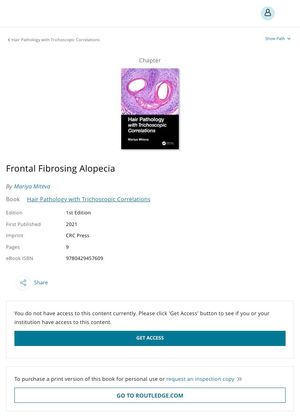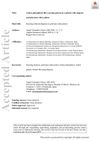Frontal Fibrosing Alopecia: Clinical Patterns and Associations
September 2021
in “
CRC Press eBooks
”
Frontal Fibrosing Alopecia FFA hairline recession eyebrow loss eyelash loss body hair loss genetically predisposed immuno-inflammatory disorder HLA-B*07:02 allele chromosome 6 Lichen planus pigmentosus LPPigm facial papules premenopausal women Hispanic/Latino women Trichoscopy Lichen Planopilaris LPP vellus hairs peripilar casts vessel net peripilar hypopigmented halo eyebrow abnormalities HLA-B*07:02

TLDR Frontal Fibrosing Alopecia is a hair loss condition mainly affecting postmenopausal women, with unclear causes and various clinical patterns.
Frontal Fibrosing Alopecia (FFA) is a progressive hair loss condition, most common in postmenopausal women, characterized by a band-like area of hairline recession. It can also affect eyebrows, eyelashes, and other body hair. The cause of FFA is unclear, but it is considered to be a genetically predisposed immuno-inflammatory disorder driven by the HLA-B*07:02 allele on chromosome 6. FFA presents in three common clinical patterns: a linear uniform band of hair loss, an irregular or zigzag pattern, and a 'pseudo-fringe-sign pattern'. Unusual variants and associations with Lichen planus pigmentosus (LPPigm) and facial papules have been identified, particularly prevalent among premenopausal and Hispanic/Latino women. Trichoscopy reveals features similar to Lichen Planopilaris (LPP), with additional or distinct features such as loss of vellus hairs, lack of tufts, subtle peripilar casts, vessel net, peripilar hypopigmented halo, and eyebrow abnormalities.

